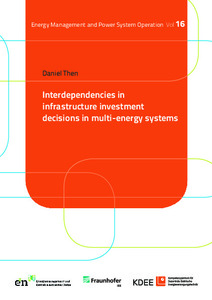| dc.date.accessioned | 2022-07-18T13:39:48Z | |
| dc.date.available | 2022-07-18T13:39:48Z | |
| dc.date.issued | 2022 | |
| dc.identifier | doi:10.17170/kobra-202203225914 | |
| dc.identifier.uri | http://hdl.handle.net/123456789/14003 | |
| dc.description | Zugleich: Dissertation, Universität Kassel, 2022 | ger |
| dc.language.iso | eng | eng |
| dc.publisher | kassel university press | |
| dc.rights | Namensnennung - Weitergabe unter gleichen Bedingungen 4.0 International | * |
| dc.rights.uri | http://creativecommons.org/licenses/by-sa/4.0/ | * |
| dc.subject | urban energy systems | eng |
| dc.subject | business dynamics | eng |
| dc.subject | multi-energy systems | eng |
| dc.subject | strategic decision making | eng |
| dc.subject | gas phase-out | eng |
| dc.subject.ddc | 333 | |
| dc.title | Interdependencies in infrastructure investment decisions in multi-energy systems | eng |
| dc.type | Buch | |
| dcterms.abstract | In the EU, the heating and cooling sector accounts for 50% of final energy demand. The EU's current climate protection goals demand a decarbonization of this sector by 80-95% by 2050. To reach this goal, one major scenario predicts the predominant use of gas-based systems supplied with CO₂ neutral gases to mitigate CO₂ emissions. A second scenario foresees a strong electrification of heating systems through heat pumps powered by renewable electricity.
Both scenarios have a strong impact on electricity and even more on natural gas distribution networks: The first scenario requires the conversion of gas grids and heating systems to the use of renewable gases and hydrogen. The second scenario largely eliminates the need for gas grids and requires the expansion of electricity grids. The corresponding impact on business models of electricity and especially gas distribution network operators (DNOs) would lead to rising and falling prices for the transport of electricity and gas. The continued operation of an existing natural gas grid in the case of a decrease in demand would increase energy-related network costs and thus grid charges, while the ongoing electrification would cause the opposite effect in the electricity grid.
For building owners, electricity and gas grid charges as part of energy costs influence investment decisions for new heating systems and heat efficiency renovations. For the gas grid, rising grid charges could thus influence building owners to move away from gas based technologies, which would accelerate the defection from the gas grid on the long run. Most studies on energy systems, building retrofitting or gas and electricity grid operation neglect these business dynamics. This thesis aims to increase the accuracy of predictions for the technological transformation of the energy system by looking at the cause-and-effect relationship between two groups of actors: The gas and electricity DNOs on the one hand and the building owners on the other hand. The proposed decarbonization measures in the German building heating sector from 2020 to 2050 form the baseline scenario to analyse the effects of this dynamic. The thesis considers the building owners retrofit decisions, the gas and electricity DNOs investment decisions and the interdependencies between them. Based on a threefold methodological approach, it addresses questions that are relevant for DNOs, policy makers and energy economists: First, a model based on data from 58 urban distribution grids in the German city of Bamberg estimates the resulting grid structure and cash flow for a future decline in gas consumption. The influence of grid-specific factors and different gas DNO strategies on grid charges is analysed for different spatial distributions of customer exits. A comparison of the total costs of grid operation for several scenarios estimates the effects on DNO business models. Second, a multi-agent simulation (MAS) is introduced to analyse the interdependencies between the building owners and the electricity and gas DNO’s investment decisions during the transformation path for a variation of regulatory, technical and economic conditions. The simulation extents the DNO cash flow model with a grid planning routine and introduces a building retrofit optimization model. Five case studies analyse the transformation path for different regulatory and technical configurations for a real grid area of the German city of Bamberg. Third, a joint mixed integer linear optimization model based on the DNO cash flow model and the building retrofit model is presented. A sensitivity analysis of 27 type building collectives and 5 grid topologies estimates the interdependencies between the electricity and gas DNO’s and the building owners’ investment decisions for a variation of building and grid specifics. | eng |
| dcterms.accessRights | open access | |
| dcterms.creator | Then, Daniel | |
| dcterms.dateAccepted | 2022-01-28 | |
| dcterms.extent | xiv, 195 Seiten | |
| dc.contributor.corporatename | Kassel, Universität Kassel, Fachbereich Elektrotechnik / Informatik | |
| dc.contributor.referee | Braun, Martin (Prof. Dr.) | |
| dc.contributor.referee | Hoffmann, Clemens (Prof. Dr.) | |
| dc.publisher.place | Kassel | |
| dc.relation.isbn | 978-3-7376-1027-8 | |
| dc.subject.swd | Energiewirtschaft | ger |
| dc.subject.swd | Stadt | ger |
| dc.subject.swd | Energieversorgung | ger |
| dc.subject.swd | Elektrische Energieverteilung | ger |
| dc.subject.swd | Gasverteilungsnetz | ger |
| dc.subject.swd | Entscheidungsfindung | ger |
| dc.subject.swd | Hauseigentümer | ger |
| dc.subject.swd | Interdependenz | ger |
| dc.type.version | publishedVersion | |
| dcterms.source.series | Energy Management and Power System Operation | |
| dcterms.source.volume | Vol. 16 | |
| kup.iskup | true | |
| kup.price | 39,00 | |
| kup.series | Energy Management and Power System Operation | eng |
| kup.subject | Naturwissenschaft, Technik, Informatik, Medizin | |
| kup.typ | Dissertation | |
| kup.institution | FB 16 / Elektrotechnik / Informatik | |
| kup.binding | Softcover | |
| kup.size | DIN A5 | |
| ubks.epflicht | true | |



